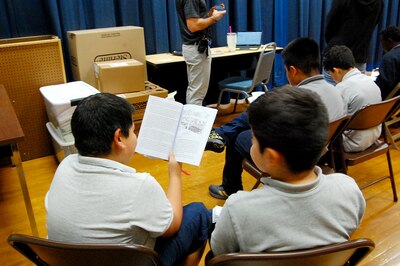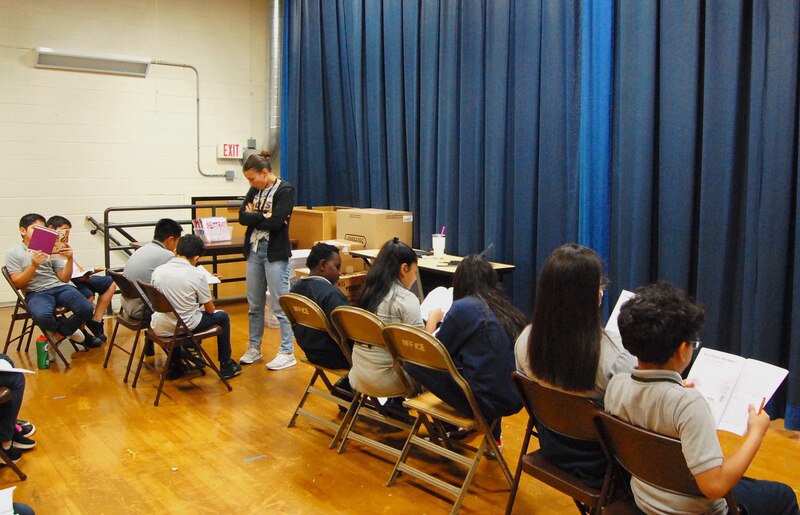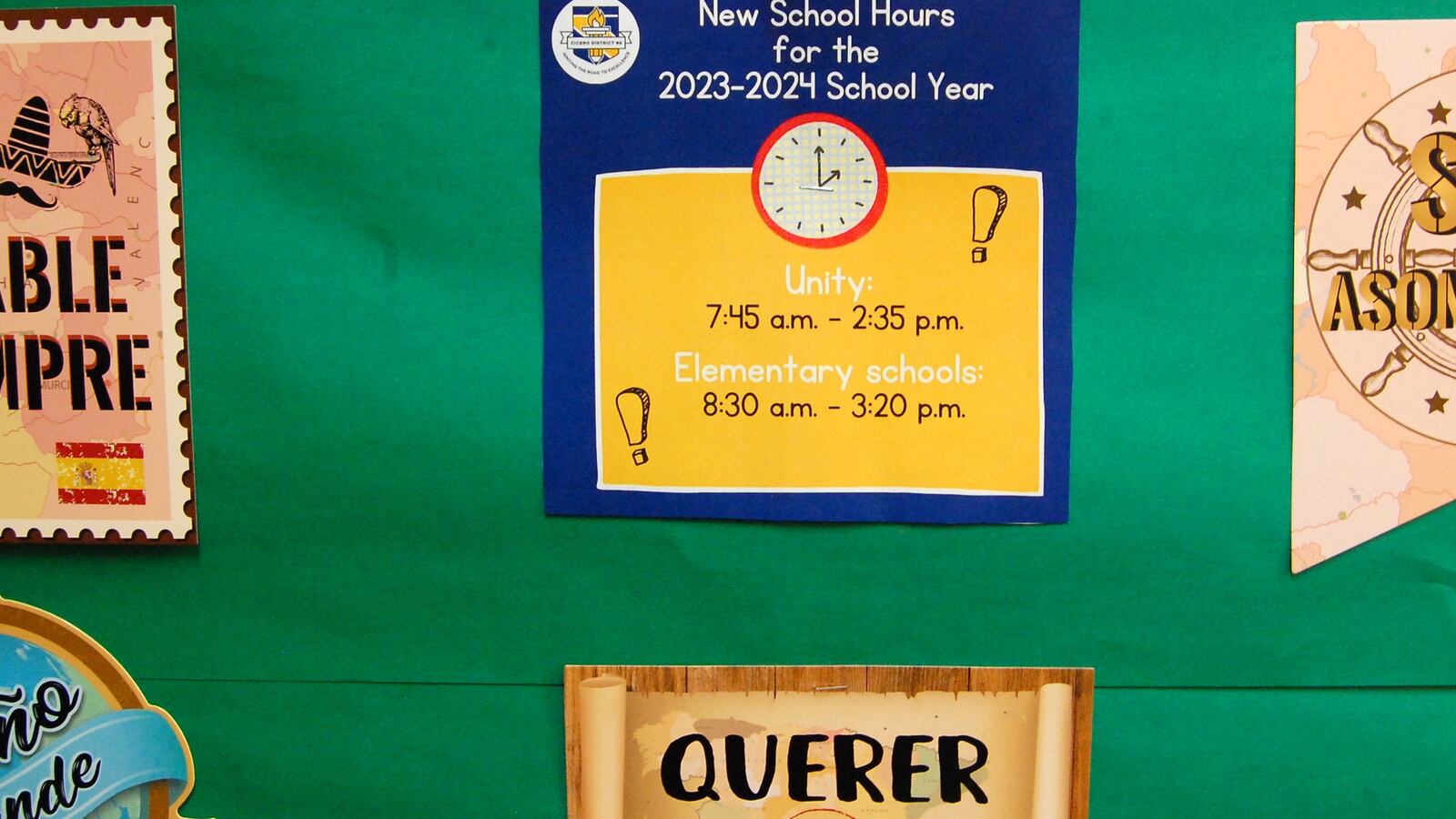Sign up for Chalkbeat’s free weekly newsletter to keep up with how education is changing across the U.S.
CICERO, Ill. — It was just after 2:30 p.m. on a recent Wednesday, and the school stage hadn’t yet transformed into a reading room.
Christopher VanderKuyl, an assistant principal in Chicago’s west suburbs, hurriedly dragged brown folding chairs across the wood floor. He made a mental note to figure out who’d rearranged the furniture.
“They can’t do that,” VanderKuyl lamented to his co-teacher, Megan Endre. “We’re using this as a classroom!”
A year ago, school would have been over around this time, and the students at Columbus East Elementary would be walking out the door. But this year, a group of fifth graders were instead sitting on the school’s stage, reading aloud about the life of Rosa Parks as they worked on reading fluency and comprehension. Similar activities were taking place in nearly every corner of the school: In another classroom, students rolled dice to practice two-digit multiplication and huddled close to their teacher to review their work.
What’s happening at Columbus East is one of the rare efforts nationally to give students more instructional time in an attempt to make up for what they lost during the pandemic. Here in Cicero School District 99, students are getting an extra 30 minutes of reading or math instruction every day, which adds up to around three additional weeks of school. School leaders hope that will be enough time to teach students key skills they missed and boost test scores.
“We do a lot of good things for our students, we have many, many resources, but our students need more,” said Aldo Calderin, the district’s superintendent. “There are challenges, I’m not going to sit here and say that there’s not. But I know that we’re doing right by our kids.”

The district is about a month into the extra academic lessons, and staff say they’re still working out the kinks. The initiative has added new instructional challenges for Cicero teachers, who were already busy putting a new reading curriculum in place and helping students cope with the ongoing fallout of the pandemic.
Still, Cicero stands out for making a longer school day a reality. While many schools used COVID relief funding to beef up summer school or add optional after-school tutoring, far fewer added extra time to the school day or year.
In Cicero, a new teachers union contract, extra pay for teachers, and school board support helped make the change happen. Elsewhere, efforts to add instructional time have faced pushback from school board members and teachers who thought the added time would be too costly and disruptive.
Thomas Kane, a Harvard education professor who has studied learning loss during the pandemic, said “it’s great to see” districts like Cicero adding instructional time.
“It obviously depends, though, on how that time is used, especially if it’s coming at the end of the day, when kids or teachers might be tired,” Kane said. “But honestly at this point, more instructional time is what’s needed to help students catch up.”
How Cicero students got a longer school day
Cicero 99, which runs through junior high, serves around 9,200 students in a working-class, mostly Latino suburb of Chicago. About three-quarters of students qualify for free or reduced-price lunch and more than half of students are learning English.
School leaders floated the idea to lengthen Cicero 99’s school day before COVID hit, but the proposal took on greater urgency when educators saw how the pandemic set students back in reading and math.
The year before the pandemic, 22% of students in the district met or exceeded Illinois’ English language arts standards, while 16% cleared that bar in math. By spring 2021, after students spent nearly a year learning remotely, 10% met state standards in English and 5% met them in math.
At Columbus East, staff recall students who hid under bed covers or pointed their cameras at ceiling fans during remote learning. Others had trouble hearing over blaring TVs, barking dogs, and whirring blenders.
Kane’s research into district-level learning loss found that Cicero students in third to eighth grades lost the equivalent of a third of a year in reading from spring 2019 to 2022, and a little less than half a year in math. The losses were similar to those in other high-poverty Illinois districts, Kane said, but still “substantial.”
“There is a sense of urgency,” said Donata Heppner, the principal at Columbus East, who’s part of the district team that planned for the extended day. “If we don’t grow more than expected, we’re never going to catch up.”
So last year, Calderin, with the school board’s support, negotiated a new contract with the teachers union that included the longer school day.

“At the beginning, we were: No, no, no, no, no,” said Marisa Mills, the president of Cicero’s teachers union and a seventh grade English language arts teacher at Unity Junior High. “And then we really started to get down to the nitty gritty, and started to talk about: Well, what if we did do this?”
Teachers got on board after the district agreed that the extra time would be used only for instruction, Mills said, and that students wouldn’t be tethered to a device during that time. Teachers also got a “very fair” bump in compensation: A 10% raise, and a one-time $5,000 bonus for this school year, paid for with COVID relief dollars. The deal, which runs through 2026, got the support of 70% of teachers.
It helped, Calderin said, that the extra time was well-received by families. Many students’ parents work multiple jobs and struggle to arrange after-school care for their children — an issue somewhat alleviated by a longer day.
Here’s how the longer day works: The district gave students pretests and used those to group students with similar abilities. Students spent the first month of the school year practicing walking their routes to their extended-day groups and getting to know their new teachers.
Now students spend two weeks in a reading group, then two weeks in a math group, or vice versa, and then get reshuffled based on how they’re doing. The district provided lessons and activities for teachers that tie in with the district’s usual curriculum.
But there’s no additional staff working the extended day. So it takes everyone, from paraprofessionals to social workers to principals, to make it work.
On that recent Wednesday at Columbus East, VanderKuyl and Endre circulated among 16 fifth graders as they read. This group spent all of second grade learning remotely and now many struggle to write their letters in a straight line or pay attention when a teacher is talking.
VanderKuyl stopped to help one student pronounce “prejudice,” while Endre urged a distracted student poking her pen in the air to follow along.
“Alright, who would like to share their summary out loud?” Endre asked.

She pressed her students to elaborate — “Who’s the man you’re talking about?” — and checked to make sure they got the details right: “It wasn’t a school bus right? It was a public bus.” Her goal this year is to boost students’ confidence and help more students read at a fifth grade level on their own.
It’s about “building that independence in reading for them,” Endre said. “Maybe not necessarily ‘Oh, I can read a whole fifth-grade level text myself.’ But can I read and understand a paragraph?”
Longer school day is not without challenges
While it may seem simple, adding 30 minutes to the school day presents plenty of instructional challenges.
Not every adult is a math or reading specialist, so some staff need extra practice and training. The extended-day groups are smaller than students’ usual classes, but are still large enough that it can be challenging for teachers to provide one-on-one attention. Some students are hungry and tired at the end of the day and miss going home earlier.
“My brain is too over-capacitated!” said one fourth grader with dark hair and white-rimmed glasses at nearby Sherlock Elementary.
And some students struggle with the frequent regrouping. Columbus East, for example, has a program for students with emotional disabilities who typically learn in the same classroom all day. Some have found it challenging to be in a new environment with different peers and without their usual teacher.
On that recent Wednesday, a student sitting at the back table in Arlen Villeda’s fifth grade math group sobbed as she struggled with the extended-day lesson. At first, the student loved the extra math lessons, Villeda said later, but as the classes got harder, the student’s frustration started to mount.
“I hate my life!” she cried. “Everyone is done!”
Villeda tried to keep moving forward with the four students seated in front of her, as a classroom aide nudged the crying student to take a break.
Villeda has tried strategies shared by the student’s usual teacher — like walking the student to the familiar calming corner in her classroom when she gets overwhelmed — but Villeda says it can be challenging to know exactly how to help. For some students, she said, “consistency really makes a big difference.”
“Like with anything, we know that change is going to become easier as time goes on,” she said. “But I honestly feel like this is still an adjustment period for us — for the teachers and for the students.”
For now, Heppner, Columbus East’s principal, and others are revisiting how the extended day is going and making changes when needed. Going forward, for example, teachers will have more say over how students are grouped. And teachers can ditch activities that were “a total bomb,” as Heppner put it.
Mills, the union president, said she knows some teachers, especially those who don’t specialize in reading and math, are struggling with extra preparation work. But already she’s seeing glimmers of progress. She feels like she can do more with her seventh graders in the smaller extended-day groups, and some have made strides in their reading.
“It’s going to be a little nuts for the first year, for sure,” Mills said. “But if this is something we really want to do for our students, that’s what it’s going to have to be.”
Kalyn Belsha is a senior national education reporter based in Chicago. Contact her at kbelsha@chalkbeat.org.


